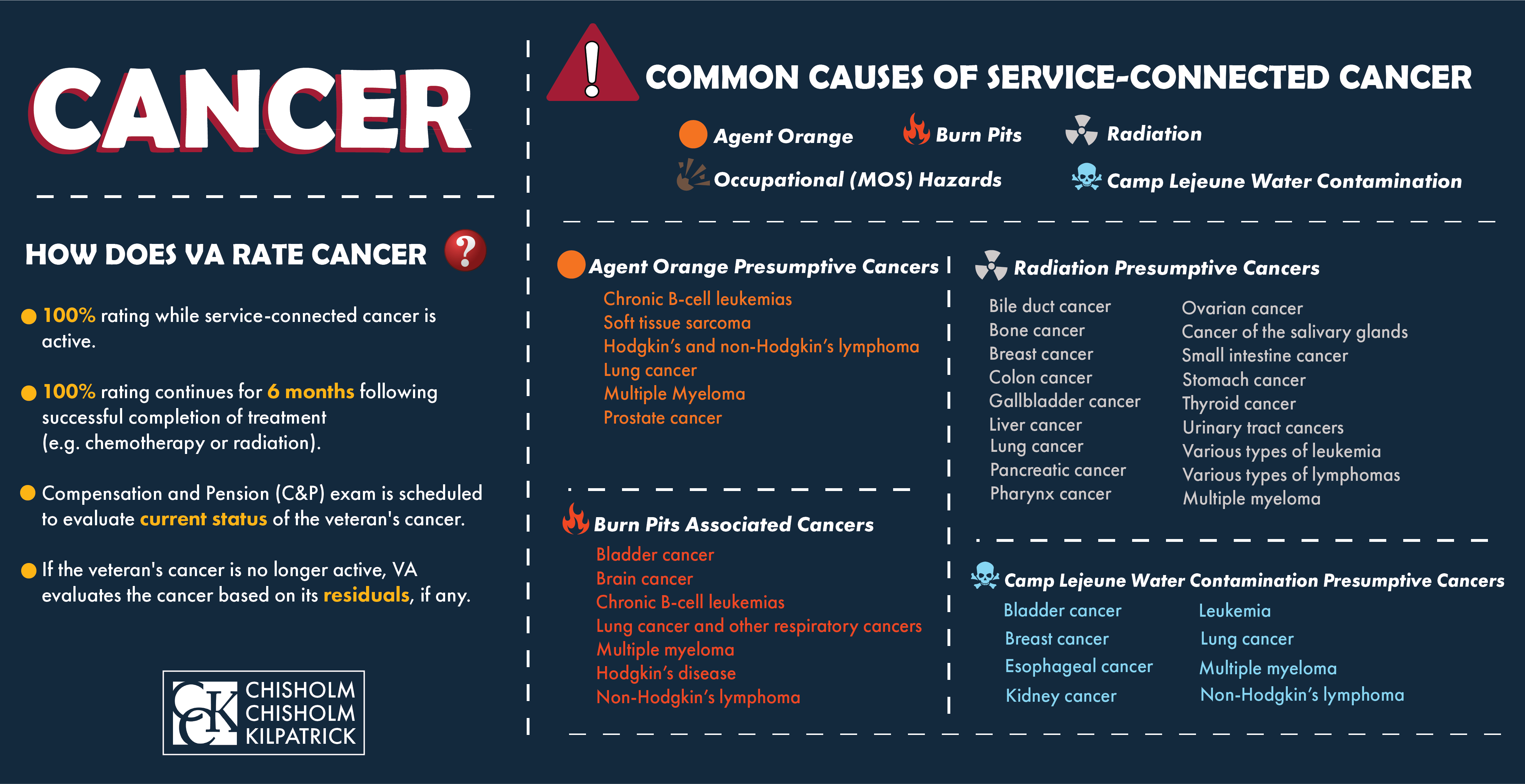VA Disability for Head and Neck Cancers

CCK Law: Our Vital Role in Veterans Law
On August 10, 2022, the Honoring Our Promise to Address Comprehensive Toxics (PACT) Act of 2021 added 23 conditions to the Department of Veterans Affairs’ presumptive list for military toxic exposure. Among these conditions are head cancers and neck cancers.
What Are Head and Neck Cancers?
Head and neck cancers are cancers that affect several areas of the head and throat, not including brain or eye cancers. According to the Centers for Disease Control and Prevention (CDC), head and neck cancers account for about four percent of all cancers in the United States. More specifically, around 68,000 people in the United States were diagnosed with head or neck cancer in 2021.
Generally, head and neck cancer can form in the:
- Oral cavity: Symptoms include a white or red patch on the gums, tongue, or lining of the mouth. Additionally, the jaw may swell, or a growth may form, leading to unusual pain or bleeding in the mouth.
- Throat (pharynx): Symptoms include pain when swallowing; persistent pain in the neck or throat; and pain or ringing in the ears.
- Voice box (larynx): Symptoms include difficulty breathing or speaking; earaches; and pain when swallowing.
- Paranasal sinuses and nasal cavity: Symptoms include blocked sinuses that do not clear; chronic sinus infections that do not respond to antibiotics; nose bleeds; headaches; swelling in the eyes; and pain in the upper teeth.
- Salivary glands: Symptoms include swelling around the jaw or under the chin; numbness or paralysis of facial muscles; and persistent pain in the chin, neck, or face.
The most common forms of head and neck cancers begin in the squamous cells lining a person’s head and neck mucosal surfaces (e.g., inside the mouth and throat). These are known as squamous cell carcinomas of the head and neck. Cancers that form in the sinuses, salivary glands, or muscles and nerves in the head and neck are much less common that squamous cell carcinomas.
Types of Head and Neck Cancers
Head and neck cancers include (but are not limited to):
- Hypopharyngeal cancer
- Laryngeal cancer
- Lip and oral cavity cancer
- Nasopharyngeal cancer
- Oropharyngeal cancer
- Paranasal sinus and nasal cavity cancer
- Salivary gland cancer
- Squamous cell neck cancer
- Soft tissue sarcoma
- Thyroid cancer

Head and Neck Cancers Treatments and Side Effects
Treatments for head and neck cancer may include radiation therapy, chemotherapy, targeted therapy, immunotherapy, surgery, or a combination of these treatments. A patient’s treatment depends on the location and stage of the cancer, as well as their age and general health.
These cancer treatments may lead to certain side effects and residual symptoms in patients. For example, individuals who underwent a surgery for throat cancer may find it difficult to chew, swallow, or even talk. Additionally, following a laryngectomy (i.e., surgery to remove the voice box), a patient may experience numbness in the throat and neck due to certain nerves being cut.
Individuals who receive radiation therapy may experience side effects during and after the treatment, including:
- Difficulty swallowing
- Changes in taste
- Nausea
- Redness, irritation, and sores in the mouth
- Thickened saliva or dry mouth,
- Loss of taste
- Earaches
- Decrease in appetite
Although many of these side effects will improve over time, some individuals experience long-term effects, such as speech impairment, difficulty swallowing, and skin changes.
Service Connection for Head and Neck Cancers
Generally, securing Department of Veterans Affairs (VA) disability benefits requires three things:
- An in-service event, injury, or illness;
- A current diagnosis by a medical professional;
- A medical nexus, or link, between the in-service event and current diagnosis.
Importantly, veterans must demonstrate a connection between their military service and their head or neck cancer. Veterans can support their claim by securing a private nexus opinion from a medical professional and by submitting lay evidence. Lay evidence, or lay statements, can be written by the veteran or anyone who knows the veteran and can speak to their condition.
VA may also schedule the veteran for a Compensation and Pension (C&P) exam to determine if a connection exists between military service and the head or neck cancer. C&P exams are also generally used to evaluate the severity of a condition.

PACT Act: Presumptive Service Connection for Head and Neck Cancers
As mentioned above, the PACT Act added 23 conditions to VA’s presumptive list for military toxic exposure, including head cancers and neck cancers of any type. To be eligible for presumptive service connection for head or neck cancer, veterans simply must have evidence that they served in one of the qualifying locations during the qualifying periods and have a medical diagnosis of neck or head cancer. This presumption also applies to surviving spouses of veterans seeking retroactive Dependency and Indemnity Compensation (DIC) benefits.
Veterans can qualify for this presumption if they are considered a “covered veteran.” The bill defines covered veterans as the following:
- A veteran who, on or after August 2, 1990, performed active military, naval, air, or space service while assigned to a duty station in, including air space above:
- Bahrain
- Iraq
- Kuwait
- Oman
- Qatar
- Saudi Arabia
- Somalia
- United Arab Emirates
- A veteran who, on or after September 11, 2001, performed active military, naval, air, or space service, while assigned to a duty station, including the airspace above:
- Afghanistan
- Djibouti
- Egypt
- Jordan
- Lebanon
- Syria
When President Biden officially signed the PACT Act into law, he and VA Secretary McDonough announced that the rollout period for certain presumptive conditions for covered veterans would be waived. Initially, these presumptions were effective upon the date of enactment of the PACT Act only for certain conditions, while presumptions for other conditions would become effective on a rolling basis over the next few years. Now, with this new rollout plan, the presumption for all conditions are effective from the date the PACT Act was signed (August 10, 2022) and VA will begin adjudicating these claims as soon as January 2023. Veterans should know, however, that newly eligibly claimants will not get retroactive benefits back to the date of their original claim unless they are filing a claim for DIC benefits.
View the full list of toxic exposure presumptive conditions here.
VA Disability Ratings for Head and Neck Cancers
VA automatically assigns a 100 percent disability rating to veterans with a service-connected active cancer, including head and neck cancers. This rating continues for as long as the cancer is active, and then for another six months following the successful completion of a treatment program, such as chemotherapy, radiation, or surgery.
VA will then schedule a C&P examination to reevaluate the status of the cancer. If the examination shows that the veteran’s cancer is no longer active and is in remission, VA will assign a disability rating based on the severity of its residuals.
Were You Denied Disability Compensation for Your Cancer?
If VA denied you service connection for head or neck cancer, Chisholm Chisholm & Kilpatrick LTD may be able to help. The accredited attorneys and claims agents at CCK have decades of experience assisting veterans in obtaining their rightfully earned benefits. We may be able to help you too.
Call CCK today at 800-544-9144 to schedule a free consultation with a member of our team.
About the Author
Share this Post

